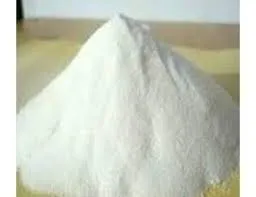
Вер . 06, 2024 03:20 Back to list
Hydroxypropyl Methylcellulose (HPMC) - Chemical Structure and Applications
The Chemical Structure of Hydroxypropyl Methylcellulose (HPMC)
Hydroxypropyl methylcellulose (HPMC) is a widely used cellulose ether that boasts a unique chemical structure, making it a versatile compound in various industrial applications, particularly in pharmaceuticals, food, and construction materials. Understanding its chemical structure provides insights into its properties and functional capabilities.
At a molecular level, HPMC is derived from cellulose, a biopolymer consisting of long chains of glucose units linked together through β-1,4-glycosidic bonds. The modification of cellulose to create HPMC involves a two-step etherification process whereby methyl groups (-OCH3) and hydroxypropyl groups (-O-CH(CH3)2) are introduced into the cellulose backbone. The degree of substitution, which refers to the number of hydroxyl groups replaced by these ether groups, significantly affects the solubility and viscosity of HPMC.
The Chemical Structure of Hydroxypropyl Methylcellulose (HPMC)
The presence of hydroxypropyl and methyl substituents in the cellulose structure results in significant changes in both physical and chemical properties. For instance, HPMC exhibits excellent film-forming capabilities, which is crucial in pharmaceutical applications where it is used as a coating agent for tablets and capsules to control drug release profiles. Its viscosity can be tailored according to the degree of substitution and molecular weight, making it suitable for a variety of formulations, from low-viscosity solutions used in eye drops to high-viscosity gels utilized in topical applications.
chemical structure of hpmc

In the food industry, HPMC serves as an emulsifier, thickening agent, and stabilizer, enhancing the texture and shelf-life of food products. As a non-toxic substance, it is categorized as Generally Recognized as Safe (GRAS) by the FDA, allowing it to be widely used in food formulations without health concerns.
In construction and building materials, HPMC is employed in cement-based products and tile adhesives to improve workability, adhesion, and water retention. The polymer's unique ability to form a gel upon hydration allows for enhanced bonding properties and ease of application.
Moreover, HPMC's versatility extends to cosmetic formulations, where it acts as a thickener, film-former, and stabilizer for emulsions. Its non-irritating profile makes it a suitable ingredient for sensitive skin formulations.
In conclusion, the chemical structure of hydroxypropyl methylcellulose is pivotal to its functionality across diverse applications. The balance of hydrophobic and hydrophilic properties, influenced by the degree of methylation and hydroxypropyl substitution, allows HPMC to solve various formulation challenges in pharmaceuticals, food, and construction. As industries continue to innovate and evolve, HPMC's role remains integral, demonstrating the importance of understanding chemical structures in designing effective materials.
-
What is HPMC?
NewsJun.06,2025
-
Understanding Redispersible Powder: The Future of Construction Materials
NewsJun.06,2025
-
Understanding RDP Powder: The Ultimate Solution for Your Construction Needs
NewsJun.06,2025
-
Pure HPMC: The Ideal Solution for Modern Construction and Building Materials
NewsJun.06,2025
-
Methyl Hydroxyethyl Cellulose: A Versatile Chemical Compound
NewsJun.06,2025
-
Hydroxyethyl Cellulose Power: The Essential Chemical for Various Industries
NewsJun.06,2025







